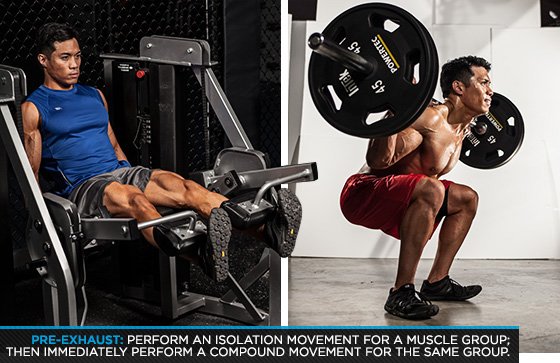As a bodybuilder, every exercise you do has a specific purpose – to make the target muscle bigger. However, a lot of lifters hit the gym like clockwork, eat like a boss, train hard and heavy, but still don’t experience much in the way of hypertrophy.
So, what’s the problem?
It turns out that, for some bodybuilders, it takes more than mindlessly doing sets of 8-12 reps to increase muscle size.
Instead, you need to make sure that the target muscle, called the agonist, is REALLY doing all the work and contracting as powerfully as possible. It’s not enough to just lift weights; you’ve got to lift those weights in a more purposeful, mindful way.
Think about it like this: If you do lat pulldowns, you want your latissimus dorsi or lats to do the majority of the work. After all, they’re the muscle you’re trying to develop. You can’t avoid using your arms during lat pulldowns, but, really, their main function is to connect your lats to the weight you’re lifting.
And yet, a lot of exercisers feel lat pulldowns in their biceps more than their lats. This results in a sub-standard lat workout and very little muscle growth.
Level Up Your Fitness: Join our 💪 strong community in Fitness Volt Newsletter. Get daily inspiration, expert-backed workouts, nutrition tips, the latest in strength sports, and the support you need to reach your goals. Subscribe for free!
How do you increase agonist engagement and make your chosen exercises are more effective?
The answer is to increase your mind-muscle connection. Using this technique, you figuratively put your brain into the muscle you are training so that you can contract it harder. A stronger mind-muscle connection will make your workouts much more productive (1).
In this article, we reveal the nine best ways to strengthen your mind-muscle connection for better bodybuilding workouts.
How to Strengthen Your Mind-Muscle Connection
A stronger mind-muscle connection could be the difference between a hypertrophy-triggering workout and just going through the motions. Connecting your brain to your muscles will allow you to contract the target muscle more intensely, ensuring that subsidiary muscles, called synergists, don’t end up doing more work than they should.
Use the following strategies to reconnect your muscles and mind for more productive bodybuilding workouts.
1. Pre-Exhaust Supersets
Bodybuilders use pre-exhaust supersets to increase time-under-tension and take their sets beyond the usual point of failure. They’re also an excellent method for reinforcing the mind-muscle connection.
To do a pre-exhaust superset, you do an isolation exercise immediately followed by a compound exercise for the same muscle group.
Examples include:
- Leg extensions before squats or leg presses
- Pec deck before bench press
- Straight arm pulldown before pull-ups
- Leg curls before Romanian deadlift
- Lateral raises and overhead presses
Because of the fatigue from the first exercise, you’ll definitely feel the agonist working when you move to the second exercise.
Related: Get More From Your Workouts with Supersets
2. Partial Reps
It’s generally best to do full-range reps for bodybuilding. However, if your mind-muscle connection needs strengthening, partial reps may help. To do partial reps, lift the weight halfway and then raise and lower it a couple of inches. Keep going until the target muscle is really burning.
Do a set of partial reps before your regular sets to put your mind into the muscle you want to train.
3. 1 ½ Reps
Like pre-exhaust supersets, bodybuilders do 1 ½ reps to increase time under tension and trigger deeper levels of fatigue. This is also a good method for reinforcing the mind-muscle connection.
With 1 ½ reps, you flex the target muscle harder and with less assistance from any synergist muscles. This should increase your kinesthetic awareness of the muscle, which is science-speak for feeling it more.
To do 1 ½ reps, lift the weight as normal, lower it down halfway, raise the weight all the way up, and then return to your starting position. That’s one rep; keep going!
Make the half rep more effective by contracting the target muscle as hard as possible. Flex, baby, flex!
4. Dynamic Tension
Dynamic tension is a form of isometric training where you trick your body into thinking you are lifting heavy by contracting your muscles as hard as you can. It teaches you to engage your muscles more purposefully, increasing the mind-muscle connection.
For example, grab a light, empty barbell and hold it with an underhand shoulder-width grip. Tense your biceps as hard as you can and very slowly curl the bar up to your shoulders. Even though the weight is very light, your biceps should be under lots of tension.
Lower the weight while maintaining your biceps contraction.
With practice, you should be able to contract your muscles very intensely without actually lifting any weight. Apply this same methodology to all the exercises in your workouts to get better results.
Read more about dynamic tension here.
5. Pre-set Isometric Contractions
Another simple yet effective way to reinforce your mind-muscle connection is to flex the muscle you’re about to train before each and every set you perform. For example, before doing squats or leg presses, contract your quads as hard as you can for 10-15 seconds. Focus on the feeling of tension radiating from your thighs.
Level Up Your Fitness: Join our 💪 strong community in Fitness Volt Newsletter. Get daily inspiration, expert-backed workouts, nutrition tips, the latest in strength sports, and the support you need to reach your goals. Subscribe for free!
Rest a moment, and then do your set. You should be much more aware of the target muscle as you pump out your reps.
6. Compression Clothing
According to Hilton’s Law, the nerves that innervate the skin also innervate the underlying muscles (2). Innervate means to activate or switch on. Therefore, if you stimulate the skin surrounding a muscle, the muscle beneath should contract more powerfully.
The easiest way to make the most of Hilton’s law to strengthen the mind-muscle connection is to wear tight-fitting compression clothing. The sensation of the fabric touching your skin will increase kinesthetic awareness and fire up the underlying muscles.
So, if you can’t feel your quads, glutes, or hamstrings working during squats, leg curls, leg presses, etc., pull on a pair of compression shorts or tights. A compression T-shirt will do the same for your pecs, delts, lats, biceps, and triceps.
7. Slap Some Skin!
If wearing compression clothing is not your thing, you can also trigger Hilton’s law by slapping the skin that covers the muscle you want to connect with. The residual tingling will help you connect your mind to your muscles, strengthening that all-important link.
While you can slap your own biceps, quads, pecs, etc., you may need a training partner to help you stimulate your back muscles. However, remember the aim of this slap is to fire up your muscles and not cause unnecessary pain.
Also, make sure you have consent to use this method. You cannot go around randomly slapping strangers, even if you are trying to make their workouts more productive!
8. Visualize
In almost every exercise and training article on Fitness Volt, you’ll find anatomical descriptions and images of the muscles you’ll be training. We include these to a) appeal to the fitness nerds (!), and b) because it’s a valuable tool for visualization.
Where your brain goes, your body usually follows, and visualizing your muscles working can go a long way to enhancing the mind-muscle link.
The next time you are training, imagine the target muscle shortening and then lengthening as you raise and lower your weights. Don’t just picture the muscle as you usually see it. Instead, strip away the skin and imagine it as an anatomical drawing. Closing your eyes may help.
The more inwardly you can direct your thoughts, and the more realistic you make the image, the more powerful this strategy becomes.
9. Use a Slower Tempo and Lighter Weights
Bodybuilders often get too hung up on how much weight they’re lifting. This can lead to less effective workouts. For example, lifting heavier weights invariably means using synergist muscles more than necessary and even cheating the weight up, both of which take the stress off the target muscles.
For example, during barbell biceps curls, it’s common to see lifters using their legs and back to raise the bar.
While this use of “body English” allows you to lift more weight or do more reps, the muscle tension gets shared throughout your body and is taken away from the muscle you actually want to train. Do this often enough, and your mind-muscle connection will break down from lack of use.
Put your mind back into your muscle by using less weight and a more controlled tempo. This will eliminate the need to use body English and ensure the load stays on the muscles you want to target.
Training lighter can be hard on your ego if you are used to training with very heavy weights. But remember, bodybuilders aren’t judged on their strength. It’s muscle size that matters most. Lifting less weight with better form could be precisely what you need to increase the mind-muscle connection and trigger hypertrophy.
So, if you can’t feel the target muscle working, don’t increase the weight. Instead, reduce the load, slow down, and you should find that your mind-muscle connection returns.
10. Include Isolation Exercises in Your Workouts
Some fitness trainers are very against single-joint isolation exercises, stating that things like pec flies, leg extensions, and triceps pushdowns aren’t very functional. They DO have a point. After all, when was the last time you did seated leg curls anywhere other than the gym?
But, bodybuilding and functional training do not have to go together. In fact, when your goal is hypertrophy, you may not have even the slightest interest in developing functional strength. Bodybuilding is all about aesthetics, right?
Anyway, isolation exercises allow you to really focus intensely on the muscle you are training. Including at least a few isolation exercises in your workouts could help build a stronger mind-muscle connection.
That doesn’t mean you can drop all those heavy-duty compound exercises from your workouts. However, you should supplement them with a few isolation exercises, too.
Mind-Muscle Connection – Wrapping Up
Successful bodybuilding is less about how much weight you lift and more about how you lift it. This isn’t a new concept and is something that the Iron Guru Vince Gironda talked about over 50 years ago.
That’s why most powerlifters, who lift very heavy, look very different from bodybuilders.
A solid mind-muscle connection is critical if you want to build bigger muscles. Reinforcing the link between your brain and your muscles means a more powerful contraction and better muscle engagement, leading to more hypertrophy.
So, if you can’t feel the target muscles working during your workouts, it’s time to start strengthening the mind-muscle connection. Use the nine strategies in this article to make your workouts more productive.
References:
1. PubMed: Importance of Mind-Muscle Connection During Progressive Resistance Training https://pubmed.ncbi.nlm.nih.gov/26700744/
2. Encyclopedia Britannica: Hilton’s Law https://www.britannica.com/science/Hiltons-law














